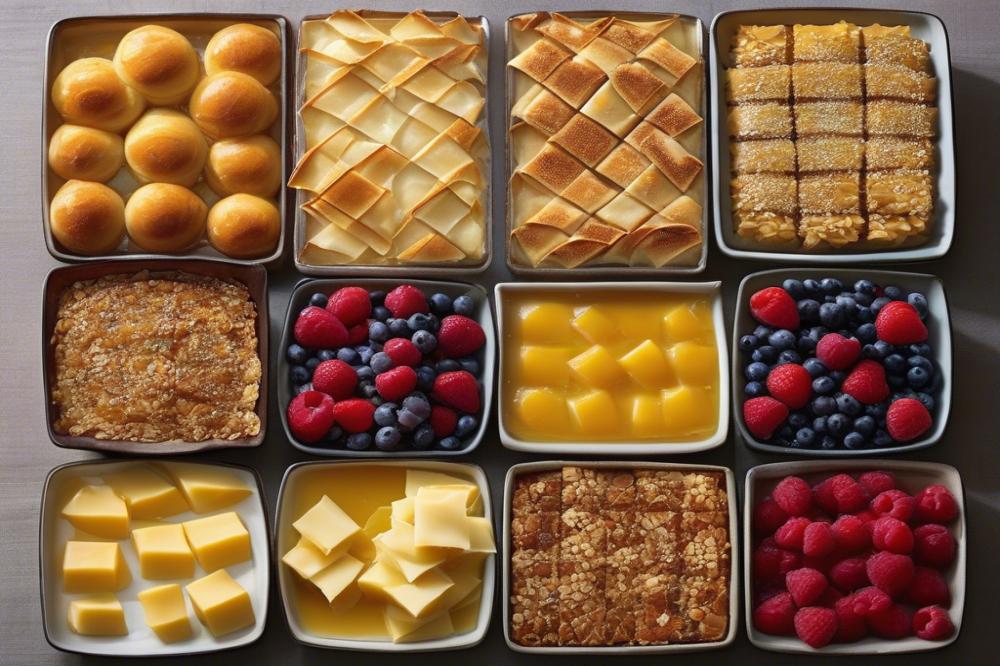Introduction
Greek desserts are a wonderful aspect of Mediterranean cuisine, offering a blend of flavors and textures that delight the senses. They are often made with fresh ingredients, incorporating nuts, fruits, and fragrant spices. Many desserts have a strong cultural significance, often enjoyed during celebrations and family gatherings. Among these, the Greek Semolina Custard stands out as a traditional Greek recipe brimming with rich history and taste.
This custard recipe showcases the beauty of semolina, a coarse flour made from durum wheat, which gives the dish its creamy texture. Semolina provides a robust base, making the dessert both filling and satisfying. Topped with flaky phyllo dough, this sweet dish gains an irresistible crunch that contrasts beautifully with the smoothness of the custard.
Phyllo dough plays a significant role in many Mediterranean desserts. Its delicate layers can elevate any recipe, adding a touch of elegance. In our version of this easy dessert, Phyllo Topping not only enhances the flavor but also improves the visual appeal, making it a true feast for the eyes as well as the palate. As we dive deeper into this delightful recipe, you will discover how to create a delicious treat that embodies the spirit of Greek culinary traditions.
What is Greek Semolina Custard?

Greek Semolina Custard is a delightful sweet dish that combines the unique flavors of semolina and cream. Semolina is a type of flour made from durum wheat. It plays a crucial role in this custard recipe, giving it a distinctive texture that is both creamy and slightly grainy. This creates a comforting mouthfeel that’s hard to resist.
The texture of this dessert is a balance between creamy smoothness and solid structure. Many describe it as velvety yet firm, making it easy to cut into slices. Flavors from ingredients like vanilla and lemon add brightness, making each bite refreshing. Often, it is topped with crispy phyllo dough, adding a wonderful contrast to the soft custard beneath.
Historically, this dish has been enjoyed across various regions of Greece. Many families cherish this traditional Greek recipe, often passed down through generations. Variations exist; some regions use different flavors or spices, while others stick closely to the classic preparation. This diversity reflects the Mediterranean’s rich culinary heritage. Regardless of the version, the heart of Greek Semolina Custard remains the same, bringing people together over a shared love for this comforting treat.
Ingredients and Measurements

To create an authentic Greek semolina custard topped with crispy phyllo dough, you will need a selection of ingredients. Here is a detailed list with precise measurements:
- Semolina: 1 cup
- Milk: 4 cups
- Sugar: 1 cup
- Egg yolks: 4
- Vanilla extract: 1 teaspoon
- Butter: 2 tablespoons (for both the custard and the Phyllo Topping)
- Phyllo dough: 10 sheets
- Cinnamon: 1 teaspoon (for garnish)
Nutritional Information
Each ingredient contributes to the overall nutrition of this delightful sweet dish. Here’s a quick look at the nutritional content of each item:
- Semolina: Provides approximately 600 calories, 130 grams of carbohydrates, and 20 grams of protein.
- Milk: Contains around 300 calories, 12 grams of fat, and a significant amount of calcium.
- Sugar: Offers about 800 calories, contributing mainly carbohydrates.
- Egg yolks: Add roughly 240 calories, along with 20 grams of protein and 18 grams of fat.
- Butter: Contributes approximately 200 calories and mainly fat.
- Phyllo dough: Each sheet is about 50 calories and primarily consists of carbohydrates.
- Cinnamon: Adds negligible calories but comes with various health benefits.
Gathering these items will help you achieve the rich flavors of this traditional Greek recipe. With these ingredients on hand, you are close to making an easy dessert that shines at any gathering.
Cooking Instructions

Step-by-step guide to making the custard
Start by heating the milk in a medium saucepan over medium heat. As it warms, add sugar to sweeten the mixture. Stir the milk occasionally to help the sugar dissolve fully. It takes a little patience, but it will pay off later.
Now, prepare to combine egg yolks with semolina. In a separate bowl, beat the yolks until they are smooth. Gradually whisk in the semolina until everything is well mixed. Once the milk is steaming but not boiling, slowly pour it into the egg mixture. Mixing constantly prevents any lumps from forming.
Return this combined mixture to the saucepan. Cook on low heat, stirring continuously. The goal is to thicken the custard without letting it boil. In about 5 to 10 minutes, the custard should reach a creamy consistency. When it thickens, add vanilla for flavor. This step brings a delightful aroma to the sweet dish.
Instructions for preparing the phyllo topping
Next, it’s time to prepare the phyllo dough. Start by preheating your oven to 350°F (175°C). Lay out a few sheets of phyllo dough on a clean surface. Brush each layer with melted butter to give it richness. Layering the dough creates a flaky texture that will complement the custard.
After layering several sheets, cut the dough into manageable squares. Arrange these squares on top of the custard mixture in a baking dish. The more layers you add, the crunchier your topping becomes. Bake in the preheated oven until golden brown, roughly 20 minutes. Keep an eye on it to avoid burning.
Assembling and final baking of the custard with phyllo topping
Once the phyllo topping is crispy, carefully remove the dish from the oven. Pour the custard into individual serving dishes or keep it all in one large dish. Spread the baked phyllo on top of the custard evenly. This adds a nice contrast of textures.
For an extra touch, you might sprinkle some cinnamon or powdered sugar on top. Return the assembled dessert to the oven for a final bake of 10 minutes. This will warm everything thoroughly and meld the flavors together beautifully. Serve warm and enjoy this traditional Greek recipe!
Serving Suggestions and Variations

Serving Greek Semolina Custard can be a delightful experience. This sweet dish is often enjoyed as a rich dessert. Timing is crucial, so serve it warm or chilled. A generous portion on a plate can impress guests. Finishing touches can enhance presentation and flavor.
Traditional Garnishes
Cinnamon is a classic topping. It adds warmth and fragrance. Another popular garnish is chopped pistachios. They not only offer a splash of color but also a pleasing crunch. Feel free to sprinkle both on top. These simple additions elevate the overall appeal of this Mediterranean treat.
Variations in the Custard Recipe
This custard recipe allows flexibility with flavors. Consider using vanilla or almond extracts for something special. Citrus zest, like lemon or orange, can brighten the dish’s profile. Additionally, you could mix in rosewater for a unique twist. Each variation creates a different flavor experience while keeping the essence of the dessert alive.
Personalizing the Dish
Personalizing your creation can make it even more enjoyable. Perhaps you enjoy a creamier texture? Adjust the milk to achieve that desired consistency. For a richer taste, consider using whole milk or a combination of milk and cream. Experimentation can lead to delightful surprises.
Using different nuts, like walnuts or almonds, can also add a nice touch. These substitutions can enhance taste and offer variety. You might even opt for a fruit topping like berries or figs to complement the custard. Your creativity delivers a new interpretation of this traditional Greek recipe.
Nutritional Benefits
Greek semolina custard offers a combination of nutrients from both semolina and dairy products. Semolina, made from durum wheat, is a good source of carbohydrates, providing energy for the body. It also contains protein and some essential vitamins and minerals, including B vitamins. This sweet dish can satisfy cravings while delivering nutritional value.
Dairy adds another layer of benefits. Ingredients like milk and cream contribute calcium, vital for strong bones and teeth. Additionally, dairy products are a source of protein that supports muscle health. This traditional Greek recipe takes advantage of these ingredients to create a satisfying experience.
As with any dessert, moderation is key. Sweets can fit into a balanced diet, but it’s important to enjoy them without overindulging. A slice of this custard recipe can be very enjoyable, but pairing it with fresh fruit or a light salad can make it a part of a healthier meal.
For those looking for lighter versions, consider using low-fat milk or a dairy alternative. You could also reduce the sugar without sacrificing flavor. Another creative tweak could be to use whole grain or spelt flour instead of traditional semolina. These small changes can still yield a delicious, easy dessert while making it a bit healthier.
Experimenting with the phyllo dough topping might also lead to a healthier dish. Instead of layering on the traditional butter, using a light spray or brushing with olive oil can cut back on calories. These modifications allow enjoyment of the rich, Mediterranean taste without excessive guilt.
Final Thoughts
The rich and creamy textures of Greek semolina custard combined with the crispy phyllo topping create a culinary experience that is truly delightful. Each bite offers a balance of sweetness and a subtle hint of citrus, giving this dessert a flavor profile that is both comforting and refreshing. It encapsulates the essence of Greek cuisine, merging old-world traditions with modern tastes.
Trying this traditional Greek recipe at home could be a rewarding adventure. Following the steps may feel a bit challenging at first, but the results will be worth the effort. Sharing it with family or friends can be a joyful experience, bringing people together to savor every mouthful.
Exploring classic Greek desserts opens a door to a wider Mediterranean culinary heritage. The array of flavors and techniques will enhance your cooking skills. Why not take a step further? Embrace the traditions, flavors, and stories that each dish brings. Your kitchen could soon become a wonderful ode to Greece.



